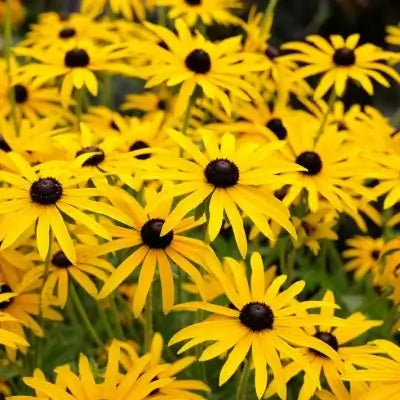
Perennials
Low maintenance and hardy
Attracts pollinators like bees
Suitable for borders and containers
Thrives in
ZONE 3ZONE 4ZONE 5ZONE 6ZONE 7ZONE 8ZONE 9ZONE 10Planting Season:
Year-RoundWhen you add one plant to cart, it automatically adds the second one free on Bogo deals.
The bellflower plant has blossoms that resemble small, graceful bells, which gives it its endearing nickname, "merry bells." These bell-shaped flowers gracefully dangle from slender stems, swaying gently in the breeze, adding a touch of elegance to the landscape.
Also known as Merrybells, belong to the Colchicaceae family of flowering plants. Its botanical name, Grandiflora, is a Latin word that translates to “large-flowered.
This mid-spring blooming wildflower is native to eastern and central North America and features the most beautiful large yellow, pendant-like, bell-shaped flowers. The vibrant yellow of the blooms and sweet nectar attract pollinators to your garden. These pollinators can enjoy the sweet nectar, collect pollens, and pollinate other plants, supporting biodiversity and local health.
This hardy plant can thrive in USDA zones 3-8, making it perfect for growing in almost any climate. If you’re looking for a showy and low-maintenance plant that looks stunning, along with other flowering plants, a bell-shaped flower plant could be your new favorite.
Due to the weight of the bell-shaped flowers, the plant's top part bends down, making it pendent.
These flowers have a sweet nectar that attracts pollinators like butterflies, mining bees, sweat bees, and hummingbirds. The plant also provides shelter and food to other wildlife and insects.
Regarding growing conditions, bellflower plants best grow in part-shade to full-shade gardens in medium-moisture, rich soil. If grown in ideal conditions, this plant can reach up to 30 inches in size and 12 inches in width.
As long as their basic growing requirements are met, they are low-maintenance and easy to care for.
They Are Stunning Perennials
You can get your plant for sale from TN Nursery today. However, they look the best when planted with other companion plants. So, you might also want to pair Merrybells with other plants such as Hostas, Solomon’s Seal, and Lily of the Valley.
They are plants that come with pretty bell-shaped flowers. They are very nice because they give you big flowers with blue, purple, pink or white flowers which are a favorite in gardens.
Where do they grow
They are very versatile and can be grown in typical garden soil, in borders, as well as in meadow sites. The plants like well-drained soil and a sunny position.
What are the best growing conditions for them
They prefer a full sun position or dappled shade on fertile, well-drained soils. These plants need frequent watering when young but can withstand dry conditions once established and, therefore, suitable in almost any landscape.
How can I incorporate them into my garden?
The bellflowers can be used in many garden layouts like cottage gardens, rockeries, and so on. Due to their erect or spreading growth, they can be used as borders, as a groundcover, or in mixed perennial beds, all while giving a pop of color during the growing season.
When do they bloom
They bloom in late spring to early summer, depending on the variety. Their long-lasting flowers provide brilliance and good looks in gardens in the warmer parts of the year and also attract bees and butterflies.

Bloom Season
Spring
Bloom/Foliage Color
Yellow
Height at Maturity
Under 12"
Care
Bellflower 'Merry Bells' thrives in well-drained soil and benefits from regular watering to moisten the soil. Fertilize in early spring. Deadhead finished blooms to promote more blooms and cut back in late fall to maintain plant health.
Plant Reproduction
Bellflower spreads by seed, rhizomes, and root fragmentation.
Planting bare-root perennials is best in any season if they are dormant; we only sell dormant plants. Planting them year-round is also excellent if you can get dormant perennials. When your bare-root perennials arrive, soak the roots in water for a few hours to rehydrate them. Lant by digging a hole wide enough to spread the roots comfortably and deep enough to place the top portion crown (where the roots meet the stem) at or slightly above ground level. Position the plant in the hole, backfill with native soil, and gently firm the soil around the roots—water well after planting to settle the soil around the plant and eliminate air. Apply a 2-3 inch layer of mulch to keep weeds at bay and moisture locked in, keeping the mulch away from the crown. Irrigate plants regularly during the first few weeks of drought; never water in full sun, and water late in the evenings to ensure the roots are established well. Fertilize sparingly in the first year, using a balanced, slow-release fertilizer in subsequent years as needed.
Shipping date depends on the date displayed and chosen when you order from the product's page.
We only accept returns on plants verified dead. If you think your plants have died, we offer a 1 year warranty, please use use this File a Claim Link to verify dead plants and start with return warranty process.



.png?v=1721999518546&em-origin=cdn.accentuate.io&em-format=auto)
Cost-Effective and Reliable
Bell Flowers are a perennial, meaning they return each year without replanting, making them a more affordable choice as they don't need annual replacement.
Pollinator Magnet
Bell Flowers are highly attractive to various bee species, enhancing your garden's appeal to pollinators. This can boost the pollination of other local plants in your area.
Delicate Elegance and Foliage:
The weight of Bell Flowers gives them a delicate, fragile appearance, while their tall green stems and hanging leaves provide excellent foliage and ground coverage in your garden.
Unique Yellow Blooms:
Merry Bells feature distinctive yellow flowers that hang upside down, adding a unique touch to your garden. Perfect for partial to full shade, they brighten up shaded areas with their vibrant color.
Caring Tips
Each box contains detailed care instructions and information about your product. But here's the basics.
Care Tips
Bellflower 'Merry Bells' thrives in well-drained soil and benefits from regular watering to moisten the soil. Fertilize in early spring. Deadhead finished blooms to promote more blooms and cut back in late fall to maintain plant health.
Light Requirements
Bellflower: Merry Bells thrive in full sun to partial shade. They prefer bright, indirect light or dappled sunlight, which helps them produce their vibrant blooms while avoiding the harshness of the direct afternoon sun. Ensure they have well-drained soil for optimal growth.
Hardy Planting Zones
3 • 4 • 5 • 6 • 7 • 8 • 9 • 10
How often should I water my plants?
How do I know if my plant is getting too much or too little sunlight?
What should I do to prepare my plants for winter?
What are the signs that my plant needs fertilizing?
How can I prevent pests from damaging my plants?
How do I choose the right plant for my climate zone?